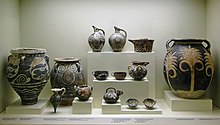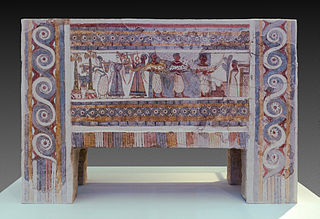Archaeological Museum Of Iraklion
The Heraklion Archaeological Museum is a museum located in Heraklion on Crete. It is one of the largest museums in Greece and the best in the world for Minoan art, as it contains by far the most important and complete collection of artefacts of the Minoan civilization of Crete. It is normally referred to scholarship in English as "AMH" (for "Archaeological Museum of Heraklion"), a form still sometimes used by the museum in itself.

The museum holds the great majority of the finds from the Minoan palace at Knossos and other Minoan sites in Crete.
History


The museum began in 1883 as a simple collection of antiquities; it was about the time when the Minoan civilization was beginning to be rediscovered, and shortly before the first excavations using proper scientific methods. It was also during the period when Crete was a virtually autonomous part of the Ottoman Empire, after the Pact of Halepa of 1878, later followed by the independent Cretan State (1898-1913), protected by a military occupation by the Great Powers. The political situation helped to keep Cretan finds on the island during a crucial period of discoveries.
A dedicated building was constructed from 1904 to 1912 at the instigation of two Cretan archaeologists, Iosif Hatzidakis and Stefanos Xanthoudidis. After three destructive earthquakes in 1926, 1930, and 1935, the museum nearly collapsed. The director of the Heraklion Museum was then Spyridon Marinatos, who made great efforts to find funds and persuade the locals and the central government alike that a new solid building was needed. In 1935, Marinatos succeeded in engaging Patroklos Karantinos to build a sturdy structure that has withstood both natural disasters and the bombing that accompanied the German invasion in 1941. Although the museum was damaged during World War II, the collection survived intact and again became accessible to the public in 1952. A new wing was added in 1964.
The Herakleion Archaeological Museum is one of the largest and most important museums in Greece, and among the most important museums in Europe. It houses representative artifacts from all the periods of Cretan prehistory and history, covering a chronological span of over 5,500 years from the Neolithic period to Roman times. The singularly important Minoan collection contains unique examples of Minoan art, many of them true masterpieces. The Heraklion Museum is rightly considered as the museum of Minoan culture par excellence worldwide.
The museum is located in the town centre. It was built between 1937 and 1940 by architect Patroklos Karantinos on a site previously occupied by the Roman Catholic monastery of Saint-Francis which was destroyed by earthquake in 1856. The museum's antiseismic building is an important example of modernist architecture and was awarded a Bauhaus commendation. Karantinos applied the principles of modern architecture to the specific needs of a museum by providing good lighting from the skylights above and along the top of the walls, and facilitating the easy flow of large groups of people. He also anticipated future extensions to the museum. The colours and construction materials, such as the veined polychrome marbles, recall certain Minoan wall-paintings which imitate marble revetment. The two-storeyed building has large exhibition spaces, laboratories, a drawing room, a library, offices and a special department, the so-called Scientific Collection, where numerous finds are stored and studied. The museum shop, run by the Archaeological Receipts Fund, sells museum copies, books, postcards and slides. There is also a café.
Most of the museum was closed for renovation from 2006 and reopened in May 2013.
The Heraklion Archaeological Museum is a Special Regional Service of the Ministry of Culture and its purpose is to acquire, safeguard, conserve, record, study, publish, display and promote Cretan artefacts from the Prehistoric to the Late Roman periods. The museum organizes temporary exhibitions in Greece and abroad, collaborates with scientific and scholarly institutions, and houses a variety of cultural events.
Collections

Room I
Covers findings from 6000 BCE to the pre-Palatial period, including:
- Neolithic fertility goddess
- Vasiliki ware
- Stone jars from the island of Mochlos
- Miniature clay sculptures
Room II
Covers findings from 2000 BCE to 1700 BCE in Knossos, Malia and several peak sanctuaries, including:
- Kamares ware pottery
- Glazed plaques of Minoan houses (aka the "Town Mosaic")
- Peak sanctuary figurines
Room III

- Phaistos Disc
- Kamares ware pottery
Room IV

Covers findings from 1700 BCE to 1450 BCE, including:
- Bull's head rhyton from Knossos
- Snake goddess figurines
- Tools and weapons, mostly cast in bronze
- Cups with Linear A inscriptions
Room V
Covers findings from 1450 BCE to 1400 BCE, including:
- Ancient Egyptian trade objects
- Clay model of a house
- Examples of a Linear A and Linear B scripts
Room VI
Covers findings from cemeteries at Knossos, Phaistos and Archanes, including:
Room VII

Covers findings from 1700 BCE to 1300 BCE from smaller villas and sacred caves, including:
- Bronze double axes
- The Harvester Vase
- Steatite vases from Hagia Triada
- Gold jewelry from Malia
Room VIII – Zakros
Covers findings from 1700 BCE to 1450 BCE from the palace of Zakros, including:
- Rock crystal rhyton
- Bull's head rhyton
- Pottery with floral and marine motifs
Room IX
Covers findings from 1700 BCE to 1450 BCE in eastern Crete, including:
- Terracotta figurines from Pisokephalo peak sanctuary
- Seal stones
Room X – Mycenaean
Covers findings from 1400 BCE to 1100 BCE, including:
- Clay figurines
- Clay sculpture of dancers with a lyre player
Room XI – Dorian
Covers findings from 1100 BCE to 900 BCE during the arrival of the Dorian Greeks, including:
- Weapons and tools, mostly of iron
- Clay fertility figurines
- Votive offerings
Room XII
Covers findings up to 650 BCE, including:
- Pottery decorated with griffins
- Artefacts and figurines from Kato Syme
Room XIII – Larnakes
Minoan larnakes (clay coffins) are on display here.
Room XIV – Hall of the Frescoes

- Frescoes from Knossos and Hagia Triada
- The Hagia Triada sarcophagus
Room XV & Room XVI
- More frescoes, including the famous "La Parisienne"
Room XX – Classical Greek, Greco-Roman
Sculptures from Classical Greek and Greco-Roman periods
Visitor information
The museum is open April–September, Monday 12–8pm Tuesday–Sunday 8am–7pm, October–March daily 8am–5pm.
EU students and senior citizens (65+) can receive a discounted entry.
There is air conditioning within the building.
Some of the collection cannot be photographed due to publication or another reason. There are usually signs posted nearby the restricted items.
Notable artifacts
Gallery
-
Minoan rhyton in form of a bull
-
Minoan jewelry
-
Fresco fragment of a dancing woman (Knossos, 1600-1450 BC)
-
Bull leaping fresco(1600-1450 BC) from Knossos palace, acrobats leaping across a bull
-
Boar tusk helmet
-
Harvester Vase
-
Statue of Isis-Persephone holding a sistrum
-
A wandering philosopher, commonly associated with Apollonius of Tyana
-
Bronze portrait statue of a youth found in Ierapetra
-
Ladies in Blue fresco
-
Lily fresco
See also
References
- ^ "Heraklion Archaeological Museum". Greek Ministry of Culture. Retrieved 18 October 2012.
- ^ History of the Museum
- ^ "Archaeological Museum | Archeological Museum | the city |".
Bibliography
- The Rough Guide to Crete. ISBN 1-84353-292-1.
External links
- Hellenic Ministry of Culture and Tourism
- Hellenic Ministry of Foreign Affairs
- City of Herakleion
- Heraklion Archaeological Museum - Ebook by Latsis Foundation
- http://ancient-greece.org/museum/muse-iraclion.html
- http://www.interkriti.org/museums/hermus.htm
- http://www.explorecrete.com/archaeology/heraklion-museum.html
- https://web.archive.org/web/20060317143414/http://www.dilos.com/location/11159
- http://www.heraklion-crete.org/archaeological-museum/
- The highlights from the collection
- Archeological Museum










